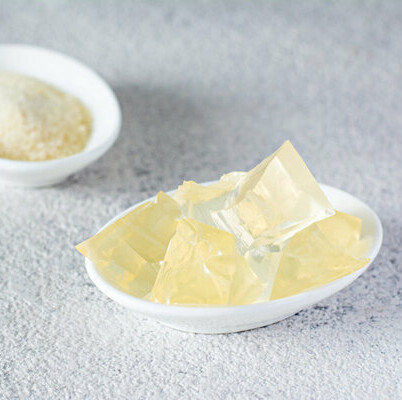
Gels
What are Gels?
Gels are viscoelastic substances capable of modifying the texture and consistency of batters, doughs and coatings. When used in small concentrations, food gels are considered food additives.1
Bakery food gels have also found use as potential replacements for fats or gluten or other main ingredients in fat-free or gluten-free formulations, respectively.1 Food gels are commonly classified into 3 main categories according to their origin:1
- Protein-based (e.g gelatin)
- Polysaccharides or gums ( e.g pectin, xanthan gum, locust bean gum)
- Starches (e.g cornstarch, modified starch, instant starch)
Origin
The term gel was first used to describe a semi-solid substance discovered by the Scottish chemist Thomas Graham in 1899.2
Gels are produced when water or other molecules are entrapped in a matrix via tight bonding of large molecules such as proteins and polysaccharides; this forms a viscoelastic substance with unique physical and chemical properties.1
Function
Gels perform the following functions in bakery products:1
- Thickening agents: increase viscosity of doughs and batters.
- Texturizers: improve texture of dough and batters.
- Fat replacers: simulate some of the properties of fats like mouthfeel.
- Gluten replacers: partially acts as gluten in gluten-free products.
- Stabilizers
- Moisture absorbents
Nutrition
Due to the wide variety of gels present in baked goods a generalization of their nutritional properties is not feasible. However, for gels made from vegetable gums, their nutritional contribution is negligible due to their low concentration and indigestibility.
Commercial production
Due to the broad range of gels available in the baking industry, a wide variety of production processes can be used in their extraction.
Application
Gels have a variety of applications in the baking industry. They can be used as texturizers in doughs and batters, or as topical coatings. Recently, gels have found a renewed interest in ‘free from’ food categories such as gluten-free or fat-free formulations.3
To obtain the desired results in gluten-free or fat-free bakery products a combination of two or more gels is commonly required such as: xanthan gum, locust bean gum, CMC, HPMC or Guar gum.
The following table highlights approaches to the proper selection criteria of food gels and their expected functionality:1
| Selection Criteria | Preferable gel | Function |
|---|---|---|
| Clarity | Gelatin or vegetable gums | Do not modify clarity of the product |
| Heat sensitivity | Instant starch or gelatin | Do not require high temperatures for gelling |
| Flavor | Gelatin or pectin | Do not modify flavor of the product significantly |
| Acidity | Modified food starch | Highly stable in acidic mixtures |
| Freezing | Root starch or modified food starch | Highly stable at freezing temperatures |
| Consistency (soft – to firm) | Cornstarch stirred as it cools | Increases thickness as it cools |
| Pricing | Cornstarch | Best value for price |
Regulations
According to the FDA, the majority of common baking food gels are considered safe when used following Good Manufacturing Practices. 4
In the EU, the majority of the commonly used gels in baked goods are considered safe when following Good Manufacturing Practices and are thus considered food additives (e.g vegetable gums) are regulated by EU Commission Regulation No 1333/2008.5
References
- Figoni, P. How Baking Works: Exploring The Fundamentals Of Baking Science. 2nd ed., John Wiley & Sons, Inc., 2008.
- “Gel | Etymology, Origin, And Meaning Of Gel By Etymonline.” Etymonline.Com, 2022, https://www.etymonline.com/word/gel .
- Phillips, G. O., and Williams, P.A. Handbook of hydrocolloids. 2 nd ed., Boca Raton, FL: CRC press, 2009, pp. 186-202.
- US Food and Drug Administration. “CFR-code of federal regulations title 21.” (2017).
- European Commission (EC). Commission Regulation (EU) No 1333/2008 of the European Parliament and of the Council of 16 December 2008 on food additives. Official Journal Of European Communities, 16 December 2008.

